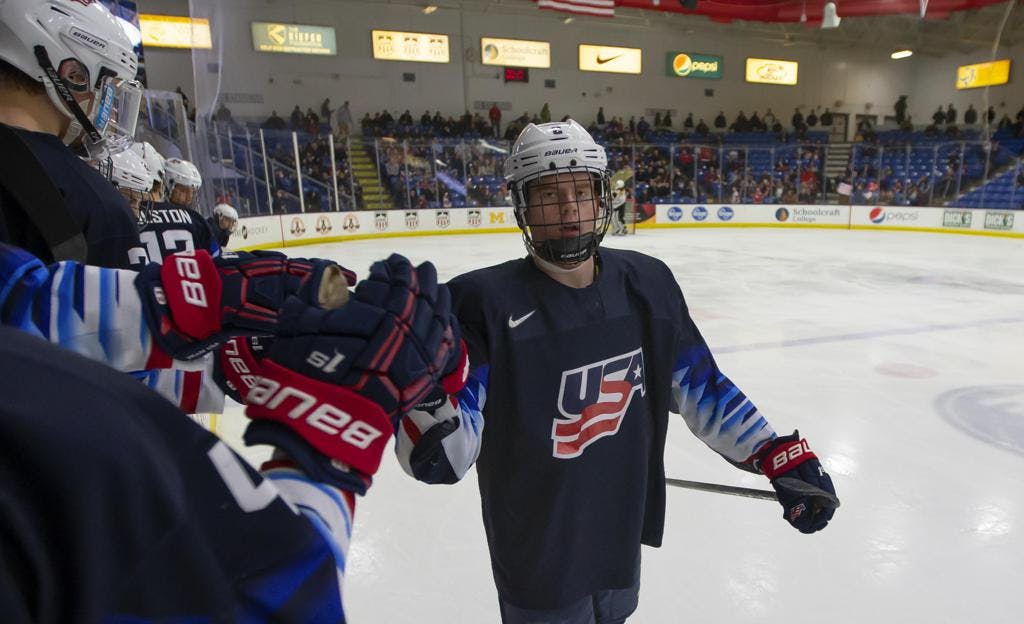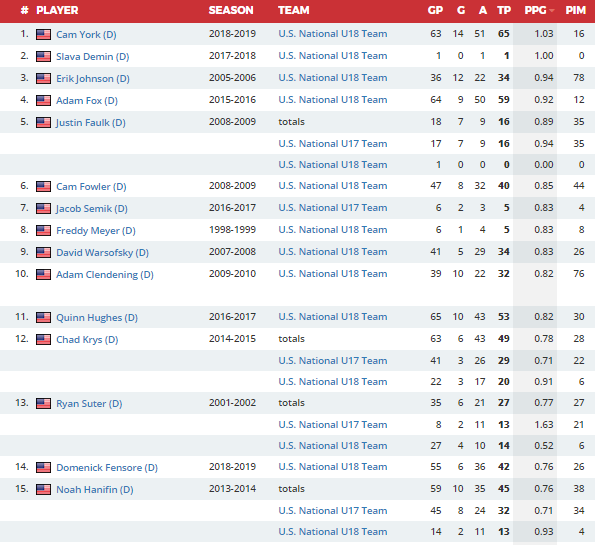NHL Draft Prospect Profile #29: Cam York

By Cameron Kuom
4 years agoWhen you think about the game of hockey’s growth and evolution over the last two decades, I can’t think of anyone in this years draft who embodies that progression more than Cam York. Hailing from Anaheim Hills, CA, he is a sub-six-foot defensemen who led the blue-line of possibly the best age group of USA hockey ever. York’s path to being a first round draft pick in the NHL would have been inconceivable not too long ago.

But thanks to the surge in scale of amateur scouting, its hard for legit talent to go unnoticed nowadays. York got his opportunity to showcase his NHL potential on the USNTDP and ran with it. He is a smooth, puck-moving defensemen with no true holes, and projects to be a solid top-4 defensemen who can run a number-one powerplay unit. However, with a slightly lower ceiling then some of his peers, he finds himself towards the back-half of my first round.
Player Information
| Name | Cam York |
| Position | Defense |
| Team | U.S. U18 (USNTDP) |
| Birthday | January 5, 2001 |
| Height | 5-foot-11 |
| Weight | 176 Pounds |
| Shoots | Left |
Player Breakdown
Skating: 55 – Puck Skills: 55 – Hockey IQ/Sense: 55 – Physicality: 40
York is pretty evidently an offensive minded defender. He does everything well from that point-of-view. While he is not as electrifying with his feet as recent first round picks like Quinn Hughes and Adam Boqvist, he processes the game just as well as anyone. He has an effective stride and an above average top-speed and first step, albeit not high-end. This gives him the capability of leading breakouts at a high level. If he can add some explosiveness to his first few steps there is a lot of potential that can be unlocked.
Evaluating this niche in his game came with its obstacles, considering he is surrounded by a multitude of impactful transition players from the USNTDP’s forward group. He doesn’t always have to be the one to create zone exits, with the likes of Jack Hughes and Alex Turcotte having a tendency to circle back and collect the puck from behind or near the net. But when York did get the chance to display his puck-moving abilities, my impressions were positive. He likes to skate the puck out himself and isn’t afraid to take it as deep as he needs to. He isn’t an Erik Karlsson type who goes for stretch passes and plays that depend on elite vision.
What is very noticeable is when he chooses to get aggressive. When there is open ice to skate up he’ll take it all day, but opts to be more conservative when there is impending pressure. While being able to recognize space is a good sign, I’m not to keen on the lack of risk to his game. Some may take that as a positive, but for an offensive defensemen who has the feet to do it, I would like to see a little more of an attack mentality.
In-terms of creating zone entries it come mostly from his ability of recognizing space. While he has some decent speed its not threatening or overwhelming for opposing defenders. One-on-one he isn’t much of a dangler either, however, has the hands to make plays, I just wish he would utilize them more in these instances.
That sentiment is especially true because York has the talent to make plays. He had a historic season for USNTDP standards, having the program’s highest scoring season by a defensemen in points and points per game of all-time.

Statistics via eliteprospects.com
Now is this extraordinary scoring rate a byproduct of the star-studded forward group York had to work with? I’d say absolutely yes, but you can’t deny this is one hell of an accomplishment. It takes an extremely smart player to be able to mesh as well as York did with his teammates.
York is absolutely capable of joining the attack and making standout plays. My gripe is he does not do it consistently. For some players that type of inconsistency may stem from a lack of confidence or hockey IQ. With York I find it to be more of a struggle to find a balance between offense and defense. That kind of reluctance is frustrating, and the consequences that come with it had little implications because his absurd forward group did most of the heavy lifting. But when York does decide to come out of his shell the rewards are promising.
York has sneaky good skill, being able to utilize his hands to extend plays and create offense. Combined with his offensive instincts and you can see the makeup of a top-4 defender in the NHL. He proved to be a efficient powerplay quarterback, manning the top unit with *checks notes* Jack Hughes, Cole Caufield, Trevor Zegras, and Alex Turcotte…yeah. Yet, with so many sticks to feed I was impressed by his ability to spread the puck around in a quick manner. Controlling the puck, he was able to pick apart penalty kills with patience and calculated puck movement. I like him a lot in that regard.
When the divide starts is with the degree of his overall upside. York plays a steady, sound game with flashes of offensive brilliance, but never comes across as an elite talent. Even in his signature eight point game this season, I came away a little shocked by the box score. He never made a play that had me saying “wow” and that is mainly due to a lack of swagger in his game. Defensively he is at a stage that projects to be adequate at the NHL level but nothing that makes me think he’ll be a horse you can rely on for twenty-five minutes a night.
With that, my liking to him has been lukewarm. In a way, I view him as a bit of a safe pick. Due to the little concerns I have about him transitioning to the NHL level, I’m confident in projecting him as a top-4 defensemen who can quarterback a powerplay, but don’t see too much after that.
Future Development
Moving forward, York will be attending the University of Michigan to play for Mel Pearson. He previously was committed to Boston College, however, decommitted after his recruiter Greg Brown left BC to become an assistant coach for the New York Rangers. UM has a great track record of developing NHL defensemen, with Quinn Hughes being the latest product to come out of that program.
I’d say York spends a maximum of two years at Michigan, if that. He already plays a mature style of game. The real benefit of going the college hockey route will be getting more opportunity to put weight on. I wouldn’t be overly surprised if he is a one-and-done and gets some AHL action towards the end of the 2019-20 season.
More 2019 NHL Draft Content from Cameron Kuom:
Recent articles from Cameron Kuom





